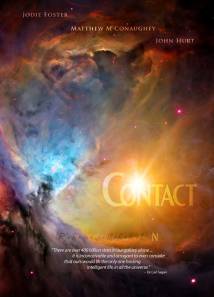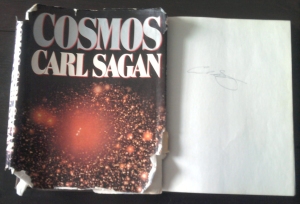As part of their brilliant science fiction season, last night BFI Southbank saw a special screening of Contact, a movie based on the novel by SETI pioneer, Carl Sagan.
 It’s not a short film, but no one in the packed audience minded that the Q&A preceding it, with Professor Brian Cox and Dr Adam Rutherford, took over an hour. Huge credit to my former employers, the British Film Institute, for not making it token, but giving us the chance for a meaty discussion on what many think is the most important question facing science: where is everybody?
It’s not a short film, but no one in the packed audience minded that the Q&A preceding it, with Professor Brian Cox and Dr Adam Rutherford, took over an hour. Huge credit to my former employers, the British Film Institute, for not making it token, but giving us the chance for a meaty discussion on what many think is the most important question facing science: where is everybody?
This was the question posed to colleagues over lunch one day (in 1950) by physicist Enrico Fermi. It has become known as the “Fermi paradox”. The “everybody” in question are aliens … extraterrestrials.
Why should we care?
Many people think the fundamental moment in the history of Western science was when Copernicus said Earth orbited the Sun rather than the other way around. This wasn’t simply a convenient coordinate shift. It was saying Earth is not the centre of the Universe. We inhabit just one of many planets. We have no privileged position in the cosmos. We are ordinary. The same “laws of nature” that apply on and around Earth apply equally in the rest of the Universe. This has become known as the “Copernican principle” and it is the foundation of scientific thought.
We have a problem. Look out at night – look further through our telescopes (and we can look so very far) and the Universe is vast. There are hundreds of billions of galaxies, like our own Milky Way. Just within ours, there are maybe 400 billion stars, most with planets. Conservative estimates, as Brian Cox told the audience (these are based on Kepler findings) hold that one in ten stars will have habitable planets in orbits that allow liquid water on their surface.
Further, at 4.5 billion years, Earth and our solar system are relatively young. The Milky War is far, far older. inally, mathematical models show it’s perfectly possible to colonize the entire galaxy in a brief time – say, 10 million years. Yet when we look skywards, we see not the slightest evidence if any intelligence in the entire Universe, other than what we find here on Earth. This suggests we are very special indeed – the polar opposite to the fundamental principle of science.
Sagan pondered this question long and hard. In his early, pioneering days of SETI, they were actively trying to communicate with extraterrestrials and before the movie, Cox and Rutherford were sitting in front of a radio message intentionally broadcast to the stars.
Sagan also helped designed messages added to the Voyager deep space probes (Voyager 1 is now over 18 light hours away, carrying a gold record with sounds of Earth and a map of how to find its inhabitants). Since those heady days, we think more about “existential risk” – things that potentially threated our survival as a species. One such risk is contact with alien races, so we’ve become more circumspect.
Looking back, I think the novel, Contact, was important for me as both a writer and publisher. I loved the story. It combined so many elements that I’m passionate about and, foolishly at the time I thought I could have told it better! Of course that’s not true, but I would nowadays have been a good editor for Sagan, had he let me. It certainly made me realize I was capable of being a good storyteller, and my current work-in-progress is a novel that revisits this same territory. I find it unfathomable now that I asked Sagan to sign my copy of Cosmos, which he kindly did, but not my copy of Contact – what was I thinking?
The film’s good, but there’s so much more in the book that anyone who likes the movie would get a lot from reading the novel. It was commented that Contact is a little overlooked as a science fiction film. Very true, but with my screenwriting hat on I think that’s because there’s so much to cram in, the narrative is very linear and straightforward. And Sagan’s thoughtful climax may have been unsatistfactory for mainstream audiences used to a different style of alien encounter.
In the movie, scientist Ellie Arroway (played by Jodie Foster and the character Cox and Rutherford said was the best depiction of a scientist on screen) detects a message from aliens, using radio telescopes. This was how Sagan and fellow SETI pioneer Frank Drake expected our first contact with extraterrestrials would go, and the film describes how things might unfold after receipt – the message is written in mathematics, the only universal language. There’s still an old-school SETI community working in this area, but increasingly scientists are thinking of alternative ways to identify evidence of aliens, often in the form of (very) large scale engineering projects such as Dyson spheres or matter-antimatter burners. We’re still looking.
If you’ve not seen the movie, you really should. Here’s the trailer to whet your appetite:
It’s part of the BFI’s excellent Sci-Fi: Days of Fear and Wonder season.






